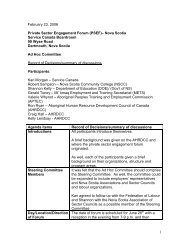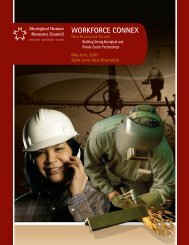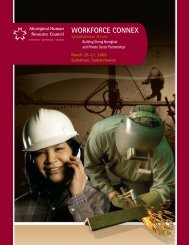Workforce connex - Aboriginal Human Resource Council
Workforce connex - Aboriginal Human Resource Council
Workforce connex - Aboriginal Human Resource Council
Create successful ePaper yourself
Turn your PDF publications into a flip-book with our unique Google optimized e-Paper software.
THE DISCUSSIONParticipants shared ideas about how to increase <strong>Aboriginal</strong> participationin trades and apprenticeship in the Manitoba region. The dialogueand deliberations at the session are contained below.WelcomeKelly Lendsay, AHRC President and CEO welcomed all participants, gave specialthanks to the elders, and introduced the dignitaries who offered opening remarks.Opening RemarksThe following leaders provided opening remarks and wished the participantswell as they completed their work for the day and a half session:•••••Minister Kerri Irvin-Ross, Minister of Healthy Living, Manitoba GovernmentGrand Chief Ron Evans, Assembly of Manitoba ChiefGrand Chief Morris Shannacappo, Southern Chiefs OrganizationGrand Chief Sidney Garrioch, Manitoba Keewatinook Ininew OkimowinPresident Lionel Chartrand, <strong>Aboriginal</strong> <strong>Council</strong> of WinnipegPART 1: Market OverviewJohn Harper, Labour Mobility Coordinator and Labour Market Analyst,Competitiveness, Training and Trade, Government of Manitoba, gave apresentation on the Manitoba labour market. The main points include:• The population in Manitoba is rising; 14 per cent of thetotal population is <strong>Aboriginal</strong>, and growing.••The population is aging as the baby boom moves through.Post secondary enrollment is up but peaking.• International immigration is strong and interprovincialimmigration is improving.• Over $13 billion of construction projects to beginin Manitoba over the next six years.• There is very little unused labour in Manitoba; unemployment rate isamong the lowest in the country; 12.1 per cent for First Nations and 7.9per cent for Métis compared to 4.1 per cent for the general population.• Education attainment for <strong>Aboriginal</strong> Manitobans islower than it is for the general population.• Of the 80 highest demand occupations in Manitoba, half are in the healthcare, trades, transportation and equipment operators occupation groups.The full text of this presentation can be found on the<strong>Workforce</strong> Connex website @ www.workforce<strong>connex</strong>.comPART 2: Walk in my Shoes / Moccasins -A Personal ConnectionIn an effort to better understand each other’s challenges, the participantsreversed roles whereby the employers were asked to think and act like theywere members of the <strong>Aboriginal</strong> community or AHRDA group, while the <strong>Aboriginal</strong>community and AHRDAs were to think and act like they were employers.A summary of the conversation is as follows:AHRDAs as businesses:Question asked… If you were a business, whatchallenges would limit your ability to make positiveconnections to the <strong>Aboriginal</strong> Community?Below is a summary of points identified (and recorded) by eachof the groups representing the supply side conversation. Thethoughts have been organized into the following themes:•••••••Communication and AwarenessEducation, Training and SkillsInstitutional BarriersCultural FactorsSpecific Needs of IndividualsRacism, Stereotypes and MisperceptionsOther Challenges and Barriers.Communication and Awareness••••We don’t advertise – tend to use word of mouth.People do not know what resources are available and how to access them.There is a lack of communication with the Aborginal community.Where do we advertise to get <strong>Aboriginal</strong> candidates?• Lack of compassion and understanding of wherethese people are coming from.••Lack of resources to locate <strong>Aboriginal</strong> people.Do not have full understanding of <strong>Aboriginal</strong> communities.• To raise awareness about barriers. Use as mentors, peoplewho have had to overcome barriers in the community.Education, Training and Skills••Aborginal people need life skills.<strong>Aboriginal</strong> people do not have enough education.• In order to move up in an organization a grade 12diploma is required for the majority of jobs.••There is a lack of communication skills.Need pre-training skills and requirements.• Must leave the community for training and there is extra costsassociated with leaving home to acquire this training.6<strong>Aboriginal</strong> <strong>Human</strong> <strong>Resource</strong> <strong>Council</strong>Manitoba <strong>Workforce</strong> Connex Report









